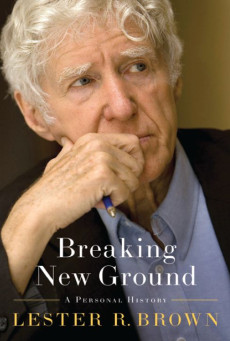About a decade ago, my youngest daughter and I went to hear Lester Brown speak. Brown, a great orator, warned a large audience about the risks of global warming and species extinction. He made a lasting impression but offered little insight into what we could do in our everyday lives to solve those problems—except, perhaps, find ways to conserve energy. Meanwhile, he was preaching to the converted at a time when public opinion polls showed that relatively few Americans took climate change seriously.
Brown is an icon of several movements: the green revolution, population control, sustainable development, and environmental conservation. He founded two think tanks, the Worldwatch Institute and the Earth Policy Institute; he is the recipient of a MacArthur “genius” award; and he has written more than two dozen books. His most recent work, Breaking New Ground, is a memoir that also includes predictions and proposals for the future. For the most part, though, that policy material reflects the author’s long-held ideas and goals. Rather than breaking new ground, Brown is tilling old fields. The book—rather like that speech—is a fascinating testament both to a life well lived and to an agenda that remains woefully unfinished.
The focus of Brown’s career has been on presenting opinion leaders and high-level policymakers with careful research and evidence-based solutions to world problems. It’s essentially a top-down approach. In describing the work of the think tanks that he founded, for example, Brown seldom refers to collaboration with other groups. Nor does he discuss the need for a broad political strategy. Instead, he highlights the number of media hits that his groups have received. “By the mid-1990s, … nothing we published was ignored. This is why Worldwatch became the most widely cited research institute in the world,” he writes. Brown, in short, is the product of an era when reasoned analysis and political leadership garnered wide respect.
Brown grew up on a farm during the Great Depression, and he was the first person in his family to earn a college degree. For many years, he ran a successful tomato farm in New Jersey. But in 1959, he left that business to join the US Department of Agriculture as an analyst. In 1965, Brown went to work in the New Delhi mission of the US Agency for International Development, and he credits the six months that he spent in India with broadening his perspective on global issues.
A pivotal moment came soon after he arrived in New Delhi. After reading local Indian newspapers and talking with people at cocktail receptions, Brown was able to determine that India was experiencing a countrywide drought and would not meet its public five-year crop projections. Famine was imminent. He sent an urgent cable on the situation that wended its way to President Lyndon B. Johnson. “I knew what India had to do,” Brown recalls. Apparently, LBJ thought so, too. The president asked Brown to draft a diplomatic agreement that tied US grain shipments to a commitment by the Indian government to intensify agricultural practices in that country. “For the United States, this was one of our finest moments,” Brown writes. “And not just because millions of lives were saved, but because LBJ saw a rare opportunity to restructure India’s agriculture.”
Brown had no qualms about strong-arming other countries in this way. He maintained that the Western model of commercial agriculture was superior to traditional models, and he did not seem to believe that the Indians (or, later, the Chinese) could find their own solutions to the challenge of food production. In the book, he does not discuss indigenous farming practices that feed people without harming the land. Nor does he write about the mass industrialization of agriculture, the use of harmful pesticides, and other aspects of the Western model that contribute to global warming.
Breaking New Ground does not address the core elements of environmental activism today: online organizing, global-scale efforts by groups such as 350.org, and increasing collaboration between environmental and human rights movements. And Brown refers only in passing to grassroots efforts such as the Sierra Club’s Beyond Coal Campaign.
Throughout his life, Brown has operated mainly as an expert analyst, not as an activist. An exception to that rule occurred when he pushed the Cosmos Club in Washington, DC, to admit women. That was, he writes, “the most intense political campaign of my life.” (Curiously, Brown never uses gender analysis in his call for population control. We know that increasing women’s access to education is the surest way to decrease birth rates.)
In 2003, Brown launched the Plan B initiative to promote population control, poverty elimination, and drastically reduced carbon emissions, among other goals. Those goals are essential to the survival of human beings and of the planet. Unfortunately, Brown—like the US environmental movement in general—no longer holds the ear of the world’s media and policy-making elite.
Brown, for his part, still believes that deploying facts, figures, and accurate analysis will lead to change. I so wish he were right.


